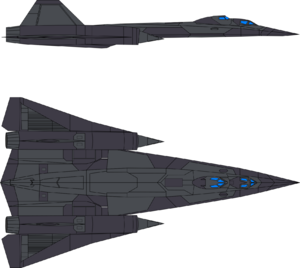Morgenroete XR-704 HARC
This article is incomplete because it is pending further input from participants, or it is a work-in-progress by one author. Please comment on this article's talk page to share your input, comments and questions. Note: To contribute to this article, you may need to seek help from the author(s) of this page. |
| Morgenroete XR-704 HARC | |
|---|---|
 | |
| General information | |
| Type | Strategic reconnaissance aircraft |
| Manufacturer | Morgenroete Aerospace |
| Designer | Leander de Vries |
| Status | Program cancelled, prototype presumed destroyed. |
The Morgenroete XR-704 HARC (High Altitude Reconnaisance Craft) was an experimental long range high-altitude reconnaissance aircraft designed and developed by Morgenroete Aerospace. The XR-704 was developed as a black project led by the Morgenroete Skunkworks division and was a manned version of the XRQ-703. Mission equipment for the aircraft included signals intelligence sensors, a side-looking airborne radar, and the newest photo sensor developed by SARA for its next generation of earth imaging satellites.
Funding for the Royal Gristo-Serkonan Air Force's High Altitude Reconnaissance Program or HARP was approved in early 2015 with its first test flight on August 2020. During aerial reconnaissance missions, the XR-704 supposedly had a theoretical maximum altitude of 28,000 metres. Its Marklin-Ashton JE-249 air-breathing engines are theoretically capable of achieving a maximum speed of Mach 3.4.
The program only built one prototype aircraft, and was eventually cancelled by the Progressive Conservative government of Kaniehtí:io Fox in early 2022 following its loss over Wazheganon airspace.
History
Test flight over Wazheganon
On March 04, 2021, the air force ordered a test flight to test the aircraft's night flying capabilities. The aircraft's pilot was Sqn Ldr Vegard Eriksen with Flight Lieutenant Tanis Johnson serving as the aircraft's weapon's systems officer took off. The aircraft took off at 6:30 standard time from Garafraxa AFB and took a northern route. Telemetry revealed a series of faults on the aircraft's aerial navigation computer and communication systems, resulting in a different route that led them flying towards the Wazheganon air defence zone. Ground personnel from Garafraxa AFB, monitored the aircraft approaching a different direction than planned tried to inform the crew of their error. The ground crew was also losing telemetry connection from the aircraft intermittently.
Flight Lieutenant Tanis Johnson soon found that their communications as well as their navigation systems have failed. She then informed Sqn Ldr Eriksen of the situation. The flight crew reinitialized their systems and begun a flight back towards friendlier airspace, presumably over Moxaney. Ground crews initially considered sending an F-104 to escort the prototype, but was considered risky given that it was already flying over Wazheganon airspace. Telemetry connection was reestablished for another 30 minutes before reporting a cascade of system failures, and a rapid loss of altitude. Both Eriksen and Johnson ejected from the aircraft as it crashed on the forested area of the Matagamon-Nyonerya border region in Wazheganon.
Crash Landing and Recovery Efforts
The Gristo-Serkonan government quickly mobilized its Combat Search and Recovery teams as it opened a diplomatic dialogue with its Wazheganon counterparts.
Squadron Leader Vegard Eriksen was later rescued by the Wazheganon's Red-Black Guard troops. Tanis Johnson managed to evade Wazheganon internal troops, making contact with agents of Gristol-Serkonos Directorate of State Security's Foreign Activities Division.
Subsequent developments following the XR-704 incident
Gristol-Serkonos
Following the end of the XR-704 affair, numerous changes occurred within the Gristo-Serkonan government. While the recovery of the pilots were a success, the destruction of the wreck and the subsequent naval skirmish was seen as an embarrassment for the government of Chancellor Fox. Numerous reappointments and removals of Ministers were made in the portfolio of Defence and State Affairs in the High Council. The High Altitude Reconnaissance Program continued on for the rest of 2021 despite the loss of the sole prototype before being cancelled by the National Office of Defence. The overall development for the aircraft and the imaging sensor technology developed by SARA has costed the government GS₵ 590.78 billion (NS$ 4 billion).